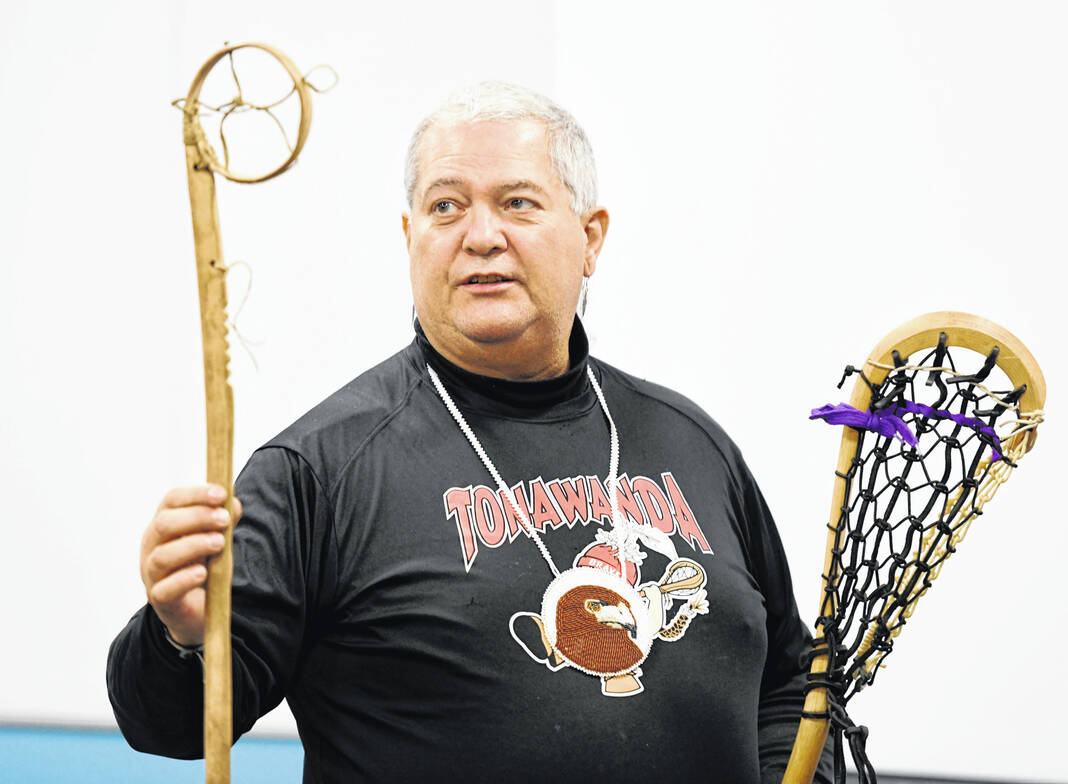
Leon Sam Briggs, a Tonawanda Seneca elder, shared his significant knowledge of the origins, traditions and spirituality of lacrosse during a visit to Wilmington College. He is displaying both a 200-year-old stick and the one he uses featuring a more modern design. Both are made of hickory.
Photo provided by Randy Sarvis
WILMINGTON — Lacrosse is known as “The Creator’s Game” to many Native Americans. For them, it takes on almost religious proportions.
“It’s not just a game, it’s what we do. It’s who we are and what we believe in.”
Those are the words of Leon Sam Briggs, an elder with the Tonawanda Seneca Nation in upstate New York, where the game was invented centuries ago in the St. Lawrence Valley bordering Canada. He was introduced at WC as an ordained spiritual leader, herbologist, cultural consultant and a master of lacrosse whose lifelong association with the sport dates back to the cradle and when he first picked up a stick in the early 1960s.
Briggs visited Wilmington College Thursday (Nov. 10) as part of WC’s programming for Native American Heritage Month. He was co-hosted by the Indigenous Students Assn. and Head Coach Garyck Todd’s men’s lacrosse team. The college has been featuring programming highlighting Native American culture throughout November.
Forget about the high-tech aluminum and titanium lacrosse sticks used by most American players today. Native American teams still use sticks fashioned from hickory. They’re hand-carved and custom-bent through a steaming process that takes from eight to 12 months.
“We bring the sticks to life while also teaching respect for the tree,” Briggs said, noting that it’s not unusual for a hickory lacrosse stick to last as long as 100 years. Indeed, his current stick is 10 years old and maintains a special history of sport dominance. “This stick has broken 500 aluminum and titanium sticks,” he said.
Briggs plays in a masters’ league with teammates ranging in age from 55 to 82 years old. “Guys your age hate it when a 67-year-old runs circles around them,” he said to the WC lacrosse players in the audience.
The design of Briggs’ stick essentially hasn’t changed in the past 150 years — and resembles today’s modern sticks albeit their metal composition. He said only a dozen traditional stick-makers remain — and he is one of them. He brought a 200-year-old stick with the circular basket style that was popular centuries ago. Of course, it’s hickory — “the mother tree” — and it features a basket with five strings representing five tribal affiliations.
In the 1600s, a French Jesuit missionary noticed the lacrosse strings forming the shape of a cross and reported to Paris the Native Americans play a game called “the cross,” or in French, “lacrosse.” Then lacrosse fields were often miles long and hundreds of men and boys played on courses laden with trees, streams and uneven terrain. There were few fixed field perimeters like the sidelines and end lines we know in today’s game. Rather boundaries were literally lines of the women and children spectators.
Balls were hardwood burls — ideal for possessing resistance to splitting and capable of traveling up to 135 miles per hour — or composed of animal fur stuffed inside a deerskin cover. Certain sacred “medicine games” featured balls with pieces of a deceased elder’s clothing inside, which represented a sign of respect.
Females are prohibited from touching males’ lacrosse sticks, as the mixing of male and female “medicine” can have a negative effect on the instrument’s spirituality. Indeed, females in Briggs’ WC audience were not allowed to handle the sticks he passed around only to the men.
Briggs plays a form of lacrosse that’s a bit different from the typical “field lacrosse” Americans know. “Box lacrosse” is based on the original game and is played on a mile-long field — yes, with trees and other obstacles — with men wearing shorts and moccasins in all kinds of weather. A 20-foot high pole emblazoned with an eagle feather stands at each end of the field of play, where goals are four feet high, significantly smaller than modern six-foot goals.
It’s also full contact with few holds barred unlike the modern men’s game, which is plenty physical but with safety limitations. The Native teams wear pads similar to baseball catcher chest protectors and the goalkeeper wears a helmet. Briggs recalled playing in the 1960s stuffing J.C. Penney catalogs into a pair of hockey pants for padding.
He said the Native American word for lacrosse means “bumping hips/we break at the hips.”
Lifelong affiliation with lacrosse begins with small sticks placed in infants’ cradles and lasts even into the afterlife, as one’s stick is the only artifact buried with the deceased.
Briggs has 14 nephews playing in professional lacrosse leagues, including Lyle Thompson, who is recognized as among the best in the world. So good are these players from indigenous populations that Native teams have played the U.S. Olympic lacrosse teams 68 times — and have never been beaten. In addition, Briggs’ masters team has never lost to a collegiate lacrosse team.
“We believe that while we’re playing lacrosse our ancestors up in the sky world are playing at the same time,” Briggs said, noting the game to them is much more than simply picking up a ball and stick and playing. He left the Wilmington College players with the message: “Remember where lacrosse comes from and give back to the game, to the young players coming up.”
That’s good medicine!

